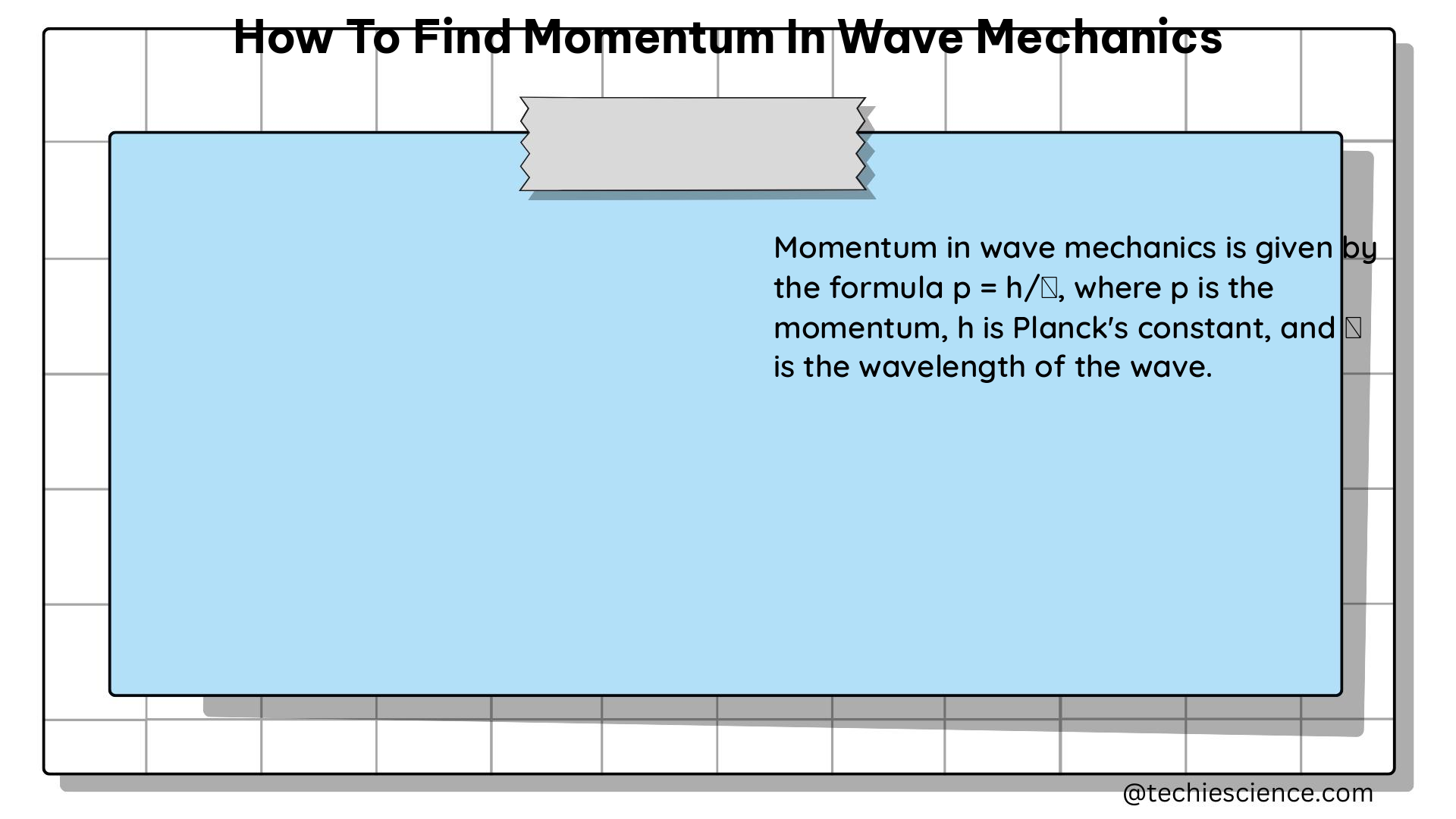In wave mechanics, the momentum of a particle is a fundamental quantity that provides valuable insights into the behavior of quantum systems. This comprehensive guide will delve into the various techniques and principles used to determine the momentum of a particle in the context of wave mechanics.
Understanding the Momentum Operator
The momentum operator in quantum mechanics is given by the expression ˆp = -iℏ d/dx, where ℏ is the reduced Planck’s constant and d/dx represents the derivative with respect to position. This operator is used to calculate the expectation value of the momentum for a given wavefunction ψ(x).
The expectation value of the momentum operator is calculated using the following integral:
<p> = ∫ ψ*(x) (-iℏ d/dx) ψ(x) dx
where ψ*(x) is the complex conjugate of the wavefunction ψ(x). This expression provides the average momentum of the particle described by the wavefunction ψ(x).
Momentum Wave Function and Fourier Transform

In addition to the expectation value, we can also determine the momentum wave function, which is the Fourier transform of the position wave function. The momentum wave function, ψ̃(p), is such that |ψ̃(p)|^2 dp represents the probability of the particle being observed to have a momentum in the range p to p + dp.
The momentum wave function and the position wave function are Fourier transform pairs, meaning that if we know one, we can find the other using the following relationship:
ψ̃(p) = (1/√(2πℏ)) ∫ ψ(x) e^(-ipx/ℏ) dx
ψ(x) = (1/√(2πℏ)) ∫ ψ̃(p) e^(ipx/ℏ) dp
These Fourier transform relationships allow us to move between the position and momentum representations of the wavefunction, providing a powerful tool for analyzing the momentum properties of a quantum system.
Uncertainty Principle and Momentum Measurement
When measuring the momentum of a quantum particle, we face the fundamental limitation known as the uncertainty principle. This principle states that the product of the uncertainties in position and momentum is greater than or equal to ℏ/2. Mathematically, this can be expressed as:
Δx Δp ≥ ℏ/2
This means that we cannot simultaneously measure the position and momentum of a particle with arbitrary precision. To measure the momentum of a particle, we need to make two precise measurements of position and time.
However, there is a challenge in making these measurements. If we make a precise first position measurement of a particle, the wavefunction collapses to a sharp peak in space, which quickly disperses as the wavefunction travels along. Therefore, making a second measurement very quickly is crucial to minimize the dispersion and the extra momentum the particle gained from the first measurement.
Practical Considerations and Examples
To illustrate the concepts discussed, let’s consider a few practical examples:
-
Particle in a Box: Suppose we have a particle confined in a one-dimensional box of length
L. The wavefunction for this system is given byψ(x) = √(2/L) sin(nπx/L), wherenis the quantum number. The momentum wave function can be calculated asψ̃(p) = (i^n √(2ℏ/L)) / (p - nℏπ/L). -
Gaussian Wavefunction: For a Gaussian wavefunction
ψ(x) = (1/√(πσ^2)) e^(-x^2/(2σ^2)), the momentum wave function is also a Gaussian, given byψ̃(p) = √(2πσ^2) e^(-p^2σ^2/2ℏ^2). -
Hydrogen Atom: In the case of a hydrogen atom, the wavefunctions are solutions to the Schrödinger equation and can be expressed in terms of spherical harmonics and radial functions. The momentum wave function can be obtained by taking the Fourier transform of these wavefunctions.
-
Numerical Example: Consider a particle with a wavefunction
ψ(x) = (1/√a) e^(-x^2/(2a^2)), whereais a constant. The expectation value of the momentum can be calculated as<p> = 0, and the momentum wave function isψ̃(p) = √(2πa^2) e^(-p^2a^2/2ℏ^2).
These examples demonstrate the application of the concepts discussed and provide a deeper understanding of how to determine the momentum in wave mechanics.
Conclusion
In this comprehensive guide, we have explored the various techniques and principles used to find the momentum in wave mechanics. From understanding the momentum operator and the momentum wave function to addressing the challenges posed by the uncertainty principle, this guide has provided a detailed overview of the essential concepts and practical considerations involved in determining the momentum of a quantum particle.
By mastering these techniques, physicists and students can gain a deeper understanding of the behavior of quantum systems and unlock new insights into the fundamental nature of the physical world.
References
- J.D. Cresser, “Observables and Measurements in Quantum Mechanics,” Physics 301, Chapter 13, 2009.
- P.A. Khan, “Position and Momentum from Wavefunctions | Quantum Mechanics” (video), 2018.
- “How can one measure the exact momentum of a particle in a quantum mechanical context?,” Physics Stack Exchange, 2022.
- “Measurement in quantum mechanics – Wikipedia,” Wikimedia Foundation, 2022.
- “Wave energy in quantum mechanics – IOPscience,” IOP Publishing, 2012.

The lambdageeks.com Core SME Team is a group of experienced subject matter experts from diverse scientific and technical fields including Physics, Chemistry, Technology,Electronics & Electrical Engineering, Automotive, Mechanical Engineering. Our team collaborates to create high-quality, well-researched articles on a wide range of science and technology topics for the lambdageeks.com website.
All Our Senior SME are having more than 7 Years of experience in the respective fields . They are either Working Industry Professionals or assocaited With different Universities. Refer Our Authors Page to get to know About our Core SMEs.